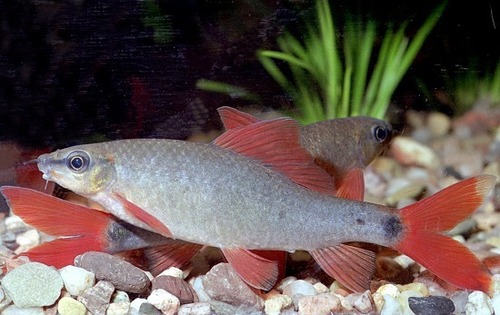
Rainbow Shark
The Atlantic bluefin tuna (*Thunnus thynnus*) is a magnificent and highly prized species of tuna. Renowned for its size, speed, and strength, it plays a crucial role in the marine ecosystem. This species is also of significant commercial importance, leading to a complex interplay between conservation efforts and fishing pressures.
4 8 years
Lifespan
15 cm
Length
Least Concern
Conservation Status
24 km/h
Swimming speed
Omnivorous, Detritivorous
Diet
Local Migration
Migration
Appearance Overview
The Atlantic bluefin tuna is a large, torpedo-shaped fish with a metallic blue-black back and a silvery-white underside.
Coloration
Dark metallic blue on top, silvery-white underside.
Body Shape
Torpedo-shaped, streamlined.
Fins
Two dorsal fins, the first depressible; small finlets running from dorsal and anal fins to the tail.
Keel
Strong lateral keel on the caudal peduncle.
Length
Up to 13 feet (4 meters), commonly 6.5 feet (2 meters).
Weight
Up to 2,000 lbs (907 kg), commonly 550 lbs (250 kg).
Diet
Carnivorous, feeding on a variety of fish (such as herring, mackerel, and hake), squid, and crustaceans.
Feeding Behavior
Highly active predator, using speed and powerful muscles to chase down prey. They often feed cooperatively, herding schools of fish.
Social Behavior
Forms schools, especially when young. Schooling behavior can be complex and related to size and age. Migratory, undertaking long trans-Atlantic journeys.
Commercial Relevance
Extremely high value, particularly in the Japanese sushi and sashimi market. A single fish can be worth tens or even hundreds of thousands of dollars.
Conservation measures
International fishing quotas, minimum size limits, time/area closures, and efforts to reduce bycatch. Monitoring and enforcement are crucial.
Status
Endangered (IUCN)
Threats
Overfishing (historically and currently the biggest threat), bycatch in fishing gear, climate change affecting prey distribution, and habitat degradation.
Habitat Distribution
Depth Range
0-1,000 meters (0-3,280 feet), but most commonly found in the upper few hundred meters.
Geographic Range
North Atlantic Ocean, Mediterranean Sea, and formerly the Black Sea.
Preferred Environment
Temperate and subtropical waters; pelagic (open ocean) species, often associating with continental shelves and slopes.
Reproduction and Life Cycle
Breeding Habits
Spawns in warm waters, primarily in the Mediterranean Sea and the Gulf of Mexico. Spawning occurs in large aggregations.
Development Stages
Eggs are pelagic (floating in the open water). Larvae hatch and develop rapidly, feeding on plankton. Juveniles grow quickly, eventually joining schools.
Fecundity
Highly fecund; females can produce up to 30 million eggs per season, depending on their size and condition.
Maturity Age
Matures at 4-8 years in the western Atlantic and around 3-5 years in the eastern Atlantic and Mediterranean.
Faqs about Rainbow Shark
Where are Atlantic bluefin tuna found?
Atlantic bluefin tuna are found throughout the North Atlantic Ocean and the Mediterranean Sea.
What do Atlantic bluefin tuna eat?
Atlantic bluefin tuna primarily eat fish, squid, and crustaceans.
How long do Atlantic bluefin tuna live?
Atlantic bluefin tuna can live up to 40 years.
Why are Atlantic bluefin tuna endangered?
They are endangered due to decades of overfishing, which has severely depleted their populations.
Do Atlantic bluefin tuna migrate?
Yes, they are highly migratory, with some populations crossing the entire Atlantic Ocean.
How fast can Atlantic bluefin tuna swim?
They can swim at speeds up to 43 mph (70 km/h), especially when chasing prey.
How many eggs can a female bluefin tuna lay?
A single female can release up to 30 million eggs per spawning season.
Why is it important that bluefin tuna are warm-blooded?
Their warm-bloodedness allows them to maintain a higher body temperature than the surrounding water, giving them advantages in speed and endurance.
At what age do Atlantic bluefin tuna reach maturity?
They typically reach sexual maturity between 4 and 8 years of age, depending on the population.
Copyright @ Nature Style Limited. All Rights Reserved.
 English
English